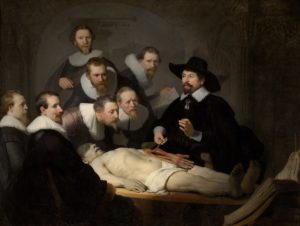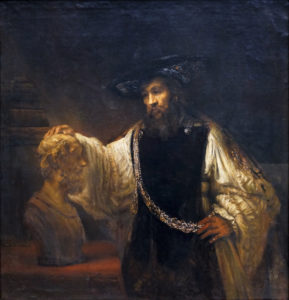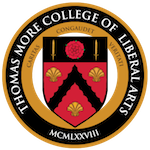by Magdalena Dajka, ’20
 On Friday, October 18, the college community convened for a Traditio day, a day on which all students and faculty consider a single work of literature, music, or art together. This month’s Traditio fell on the feast of St. Luke, the patron saint of artists and physicians, and appropriately, the theme of the day was the work of the Dutch artist Rembrandt.
On Friday, October 18, the college community convened for a Traditio day, a day on which all students and faculty consider a single work of literature, music, or art together. This month’s Traditio fell on the feast of St. Luke, the patron saint of artists and physicians, and appropriately, the theme of the day was the work of the Dutch artist Rembrandt.
Guest speaker Dr. Michael Platt gave two lectures centered on two of Rembrandt’s works. The first session took place in the early afternoon. s students and faculty entered the library’s Newman Room, they were struck by the room’s transformation: it was set up as a darkened auditorium, with the windows covered, displays of Rembrandt’s paintings on the sides, and a projector screen displaying Rembrandt’s “The Anatomy Lesson of Dr. Nicolaes Tulp” in the center. In this session, Dr. Platt, with the aid of his daughter Heather Goodman, presented a dialogue he had written, consisting of reflections inspired by “The Anatomy Lesson.” He described Rembrandt as a thinker, who could be the painter he was because he was the thinker he was. Rembrandt kept his eyes open, and he caused others to keep their eyes open, too. In “The Anatomy Lesson,” he is drawing our attention to a dead body, something we generally try not to look at, in order to inspire us to think about our own bodies, their purpose, and their mortality.
In the evening, the college community once again assembled in the Newman Room, this time to think on Rembrandt’s painting “Aristotle Contemplating a Bust of Homer.” In this lecture, Dr. Platt brought his listeners’ attention to Aristotle’s gaze. In the modern world, we are too often afraid of silence and solitude; we need to learn to gaze as Aristotle does. Though he is looking towards the bust of Homer, he is not actually looking at it, but beyond it. His gaze is attentive, not blank; gazing is something philosophic. Aristotle is viewing Homer with his mind’s eye. This painting helps us to understand what it means to philosophize. In his unusual portrayal of Aristotle, Rembrandt is showing us the source of the Philosopher’s teaching, because before teaching, there has to be learning. By placing Aristotle alongside Homer, Rembrandt also makes us think on the relationship between the philosopher and the poet. The two are different, yet there is a kinship between them, and Aristotle himself, in his Poetics, shows that there need be no quarrel between philosophy and poetry. Both the philosopher and the poet behold something. The one gazes, and the other hearkens, but they are united in wonder.
“By placing Aristotle alongside Homer, Rembrandt also makes us think on the relationship between the philosopher and the poet. . . . Both the philosopher and the poet behold something. The one gazes, and the other hearkens, but they are united in wonder.”
Dr. Platt’s lectures gave his listeners much food for thought, and the second one in particular gave them the opportunity to see the  philosopher whom they study so deeply and read so constantly in a fresh and unaccustomed light. The thoughts of the day sparked conversations that overflowed into the cafeteria, where students gathered after the lecture to enjoy cappuccinos, homemade pastries, and spirited discussion.
philosopher whom they study so deeply and read so constantly in a fresh and unaccustomed light. The thoughts of the day sparked conversations that overflowed into the cafeteria, where students gathered after the lecture to enjoy cappuccinos, homemade pastries, and spirited discussion.
